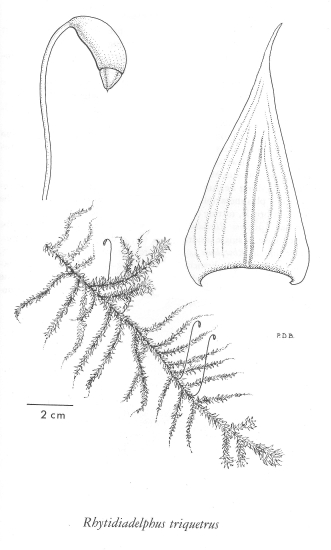Rhytidiadelphus triquetrus (Hedw.) Warnst.
electrified cat's-tail moss (rough goose neck moss)
Hylocomiaceae
Species Account Author: Wilf Schofield
Extracted from Some Common Mosses of BC
Introduction to the Bryophytes of BC
electrified cat's-tail moss (rough goose neck moss)
Hylocomiaceae
Species Account Author: Wilf Schofield
Extracted from Some Common Mosses of BC
Introduction to the Bryophytes of BC
Map
Distribution of Rhytidiadelphus triquetrus
Click here to view the full interactive map and legend
Species Information
Species description:
Species name referring to the triangular leaves and the occasional three-rowed arrangement of the uppermost leaves of some stems.
Comments:
Commonly called the rough neck moss or shaggy moss because of the untidy leaves at the shoot tips. A whimsical name, electrified cat tail moss, has gained some popularity in British Columbia.
Distinguishing characteristics:
The very coarse, pale yellow-green plants with usually untidy divergent leaves of the main stem tip and upper branches, the strongly pleated, somewhat wrinkled leaves and the two strong midribs serve as useful characters. This species is more tolerant of drier climates than the other species of Rhytidiadelphus.
Habit:
Forming pale yellow-green, loose mats of coarse, interwoven, suberect, branched shoots in which the strongly divergent leaves form bristly, untidy shoot tips.
Similar Species:
Rhytidiopsis robusta is of a similar size but the leaves are wrinkled, lack pleats and show a strong tendency to be falcate-secund. Plants tend to be golden yellow-green to brownish, rather than pale yellow-green. Antitrichia curtipendula is superficially similar but the leaf shape differs, pleats are lacking and a radiating series of costae is usually apparent (see notes under Antitrichia).
Illustration

If more than one illustration is available for a species (e.g., separate illustrations were provided for two subspecies) then links to the separate images will be provided below. Note that individual subspecies or varietal illustrations are not always available.
Illustration Source: Some Common Mosses of BC
Habitat and Range
Habitat
Usually in well-drained sites in coniferous forests, on cliff shelves and over boulders and logs; occasionally epiphytic on tree trunks. Range
World DistributionCircumpolar in the Northern Hemisphere; in North America across the boreal portion of Canada and Alaska, southward in the east in mountains to the southern Appalachians and Arkansas, in the west to California.
Status Information
Synonyms
Synonyms and Alternate Names:
Rhytidiadelphus triquetrus var. beringianus (Cardot & Thér.) Grout